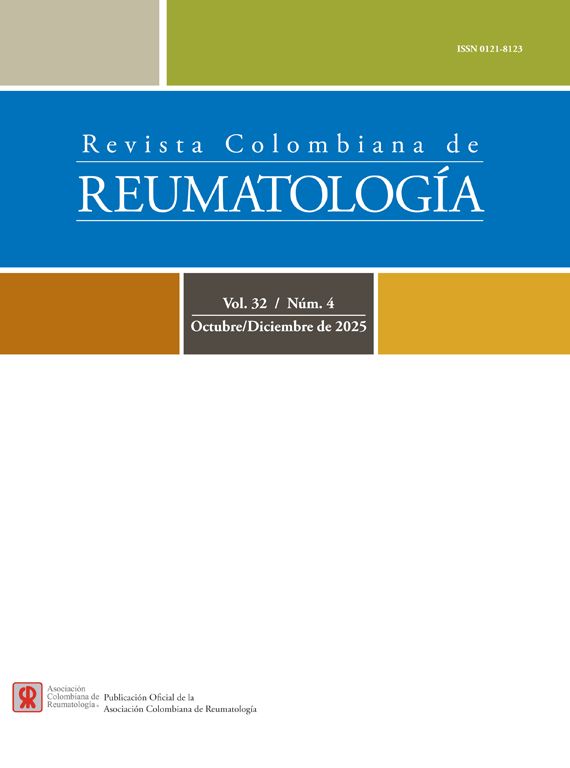Rheumatoid arthritis and ankylosing spondylitis are among the most common rheumatic diseases. The coexistence of both affections in a single patient is highly infrequent but seems to be underestimated in clinical practice.
Materials and methodsWe described the clinical, biological, and radiological characteristics of 12 patients with concomitant rheumatoid arthritis and ankylosing spondylitis diagnosed at our hospital. The 28 disease activity score (DAS28), the Bath ankylosing spondylitis disease activity index (BASDAI), and the Ankylosing Spondylitis Disease Activity Score (ASDAS) were used as outcome measures.
ResultsTwelve patients with a male-to-female ratio of 0.71 and a mean age of 62.1±12.8 years were included. Rheumatoid arthritis was the first disease diagnosed in seven patients. The mean duration of rheumatoid arthritis diagnosis at the time of ankylosing spondylitis diagnosis was 20.2±25 months. The first sign of ankylosing spondylitis in rheumatoid arthritis patients was incidental radiological sacroiliitis in four patients, inflammatory low back pain in three patients, and distal interphalangeal joint involvement in hands radiographs in two patients. Rheumatoid arthritis was seronegative in four patients. Erosions were observed on radiographs of the hands and/or feet in 66% of the cases and almost all the patients (11/12) had sacroiliitis on imaging studies. The mean values of the DAS28, ASDAS, and BASDAI scores at the initial diagnosis of rheumatoid arthritis/ankylosing spondylitis were 4.54±1.22, 3.1±0.72, and 4.1±0.5, respectively.
ConclusionThe coexistence of Rheumatoid arthritis and ankylosing spondylitis is uncommon but should be considered. We could not draw a conclusion about whether the association of both disease conditions confers different characteristics.
La artritis reumatoide y la espondilitis anquilosante son dos de las enfermedades reumáticas más prevalentes. La coexistencia de ambas patologías en un mismo paciente es rara, pero parece estar subestimada en la práctica clínica.
Materiales y métodosSe describen las características clínicas, biológicas y radiológicas de 12 pacientes con diagnóstico concomitante de artritis reumatoide y espondilitis anquilosante en nuestro hospital. Se emplearon como medidas de resultado la puntuación de actividad de la enfermedad 28 (DAS28), el índice de actividad de la enfermedad de la espondilitis anquilosante de Bath (BASDAI) y la puntuación de actividad de la enfermedad de la espondilitis anquilosante (ASDAS).
ResultadosSe incluyeron 12 pacientes, con una proporción hombre-mujer de 0,71 y una edad media de 62,1±12,8 años. La artritis reumatoide fue el primer diagnóstico en siete pacientes. La duración media entre el diagnóstico de artritis reumatoide y el diagnóstico de espondilitis anquilosante fue de 20,2±25 meses. El primer signo de espondilitis anquilosante en los pacientes con artritis reumatoide fue la sacroileítis radiológica incidental (en 4 pacientes), el dolor lumbar inflamatorio (en 3 pacientes), y la afectación de la articulación interfalángica distal en radiografías de manos en dos pacientes. La artritis reumatoide fue seronegativa en 4 pacientes. Se observaron erosiones en radiografías de manos y/o pies en el 66% de los casos, y 11 pacientes presentaban sacroileítis en los estudios de imagen. Las puntuaciones medias de DAS28, ASDAS y BASDAI al momento del diagnóstico inicial de artritis reumatoide/espondilitis anquilosante fueron 4,54±1,22, 3,1±0,72 y 4,1±0,5, respectivamente.
ConclusionesLa coexistencia de artritis reumatoide y espondilitis anquilosante es infrecuente, pero debe ser considerada. No se pudo determinar si la asociación de ambas enfermedades confiere características clínicas distintivas.








